
There is no certainty who and when constructed the first throwing machines. The ancient writer Pliny claimed that they were invented by the Phoenicians, but it can not be ruled out that the Cretans or Assyrians did it. It is certain that the latter used war machines with a very high technical level. Their contribution to the development of warfare art were enormous siege towers, also capable of crushing the walls with rams. Awareness that after conquering the city, all the defenders were murdered, meant that the battles had to be very fierce and cruel at that time. After the fall of the Assyrian in the first half of the first millennium BC the history of war machines somehow began to be written from the beginning. At that time, aggressors did not attempt to conquer cities guarded by thick and high defensive walls by direct attack, but long-lasting sieges were combined with the blockade of supply routes, waiting for hunger or thirst to force capitulation. Such sieges could last for years, which in some way forced the need to have tools capable of quicken the fighting.

The ancient Greeks certainly contributed to the development of siege engines, although still in the 5th century BC the historian Thucydides did not mention them describing the Peloponnesian war. If they existed then Greeks did not pay much attention to them. According to Diodor, a writer from the first century BC the creator of the Greek war machines was Pericles, the leader of Athens from the period of the Peloponnesian War, although he states elsewhere that they were the result of a competition organized by Dionysius I, tyrant of Syracuse, who was preparing for a military expedition to Carthage. The Greeks in the field of the siege war made many discoveries: they were able to calculate the relationship between the energy stored in the twisted fibers that gave the missile momentum and the distance the missile would fly. They also developed the first ballistic tables for the use of ratchet mechanisms that tightening the ropes to shoot. They were used to knowing exactly what range would be obtained using a missile with a particular weight. In the first half of the third century BC the principles of constructing siege machines have been standardized. The period of their greatest development can be related with the person of Alexander the Great and the Hellenistic period. This involved both the development of fortifications and siege art, and the emergence of the Alexandrian school which influenced the mathematicians and inventors such as Ktesibos of Alexandria, Heron of Alexandria, Archimedes of Syracuse, and Philo of Byzantium. Despite this, the adaptation of siege devices was still slow due to high production costs and transport problems.
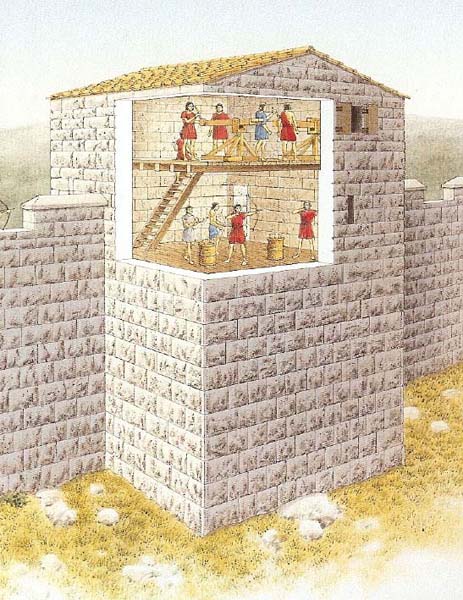
From Greeks, war machines were taken over by the ancient Romans, who from the third century BC used them commonly. Until the time of Augustus, the Roman army did not have arsenals dealing with the production of machines on a mass scale, which resulted in many difficulties and troubles. For example, during the siege of Piraeus by Sulla in 87 BC the lack of a siege fleet forced the need to bring artillery all the way from Thebes. Artillery was used by the Romans at that time mainly as an armament of the fleets and for defense and conquest of the towns, only with time it began to take part in the field battles. At the time of Julius Caesar, legions already had a small units dealing with siege machines, which, however, in large-scale operations proved inadequate. Only after the establishment of a professional army in the time of Augustus, each legion received a large unit responsible for artillery. There was one arrow-shooting machine for every centurion, and one stone-thrower for cohort, which gave 60 machins for one legion. In the second half of the third century, as a result of Diocletian’s reforms, legions lost their artillery in favor of the newly formed legions of ballistary, which were permanently incorporated into the field army in the time of Constantine. An unit with a strength of a thousand people operated with both heavy and light artillery, and was assisted by a legion of prougnatores, consisting of people assigned to siege works. More or less in this period, the town walls and forts of the Romans were equipped with heavy throwing machines.
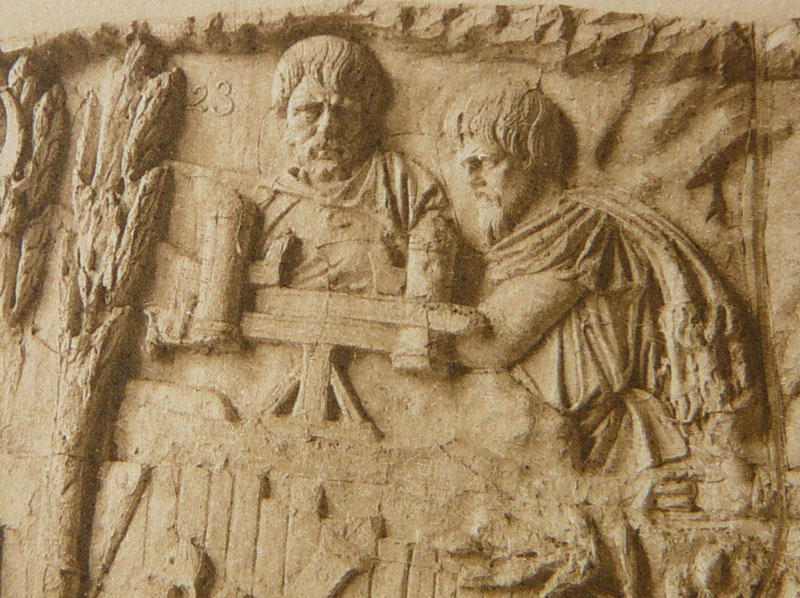
With the fall of the Roman Empire, the extended military organization collapsed and disappeared, and its only place in Europe was again Greece in the form of a Byzantine Empire. As it was constantly struggling with enemy invasions, the Byzantines developed war machines according to their needs, and their experiences were later taken over by the Arabs. Their leading invention was the so-called Greek fire and various types of siphons, pipes and tubes with which it was fired. It was a flammable mixture, probably oil or petroleum and tar, sulfur, saltpetre, resin and calcium. The production and composition of the mixture were secret in a Byzantium, and the death penalty was punishable for its disclosure. The year of invention is considered to be 674, during the siege of Constantinople by the army of the caliph of Damascus. Creation of Greek fire is attributed to the Syrian architect and chemist Kalinnikos from Helipolis..
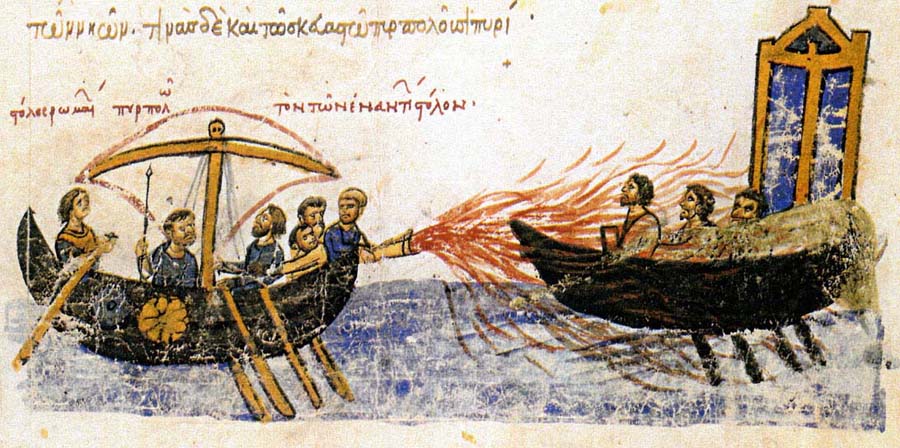
During the Middle Ages, the siege war did not differ much from that of antiquity. It was conducted in three ways: by top, through the assault on the walls, the bottom by means of digging and straight ahead through the bombardment ended with a breach, but often these three methods were used together. Classic machines, subjected to minor modifications and simplifications, were used to crumble the walls. The throwing machines, whose construction was developed in previous centuries, were still used, but as a result of the general decline of military technology, they were not comparable to those constructed in ancient times. The first use of siege artillery was recorded in France in 873. Then in 885 during the siege of Paris by the Normans, as Abbon writes, “with beams of equal length, set in pairs, they built what is commonly referred to as catapults, machines throwing huge stones that shattered the undermines of the barbarian people.” Although with the beginning of the Crusade movement, demand for siege machines increased, but it did not affect the improvement of artillery’s quality and performance from that period.
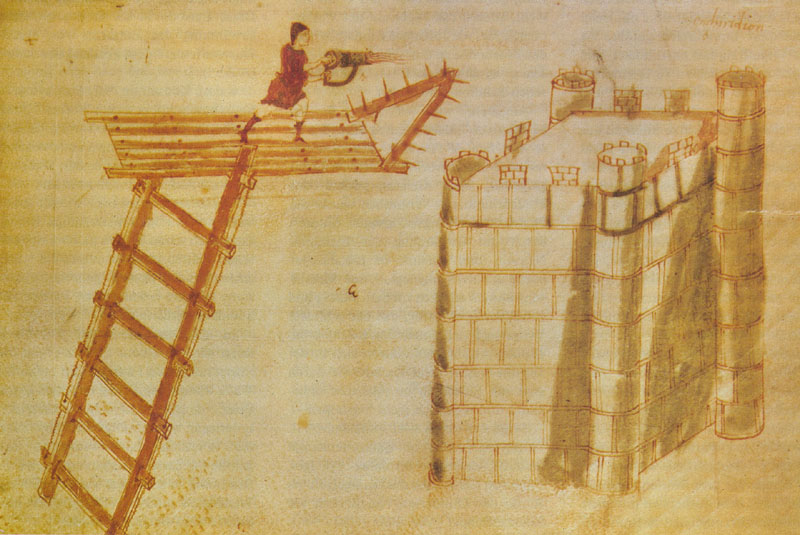
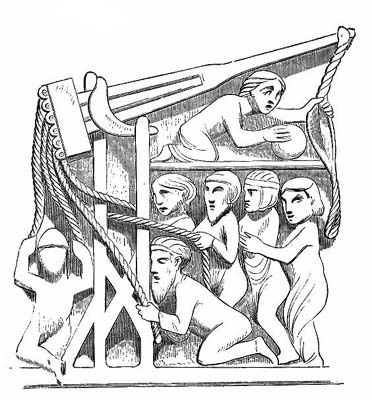
War machines were made in the Middle Ages by specialized constructors, most of whom were self-taught. Often, those less complex were built under their supervision directly under the fortifications of the besieged building, while those requiring precision were constructed earlier and delivered to the battlefield in whole or in part. In Western Europe, since the thirteenth century, mentions of engineers were more and more frequent. A certain master Urric accompanied king John in Normandy in 1201, and during the siege of Toulouse in 1218, two specialists worked for the besieged: Bernard Parayre and master Garnier. In 1220, Louis IX of France called everyone who knew how to do undermines, and also had two machines serviced by numerous masters. Some of them made long-lasting and significant careers, eg Gascon John de Mezos called the magister ingeniorum, in 1254 he was knighted. For a change, in 1376, prince Leszek the White, during the siege of Złotoria, ordered to prepare throwing machines and devices to help attack to the ordinary miller from Brześć Kujawski. Often the machines were borrowed, for example, in 1384 during internal fighting in Wielkopolska, the army of the starost of Peregrine, besieging the town of Bytyń, used machines owned by the Poznań burghers, meaning they had to be transported from a distance of 30 km.
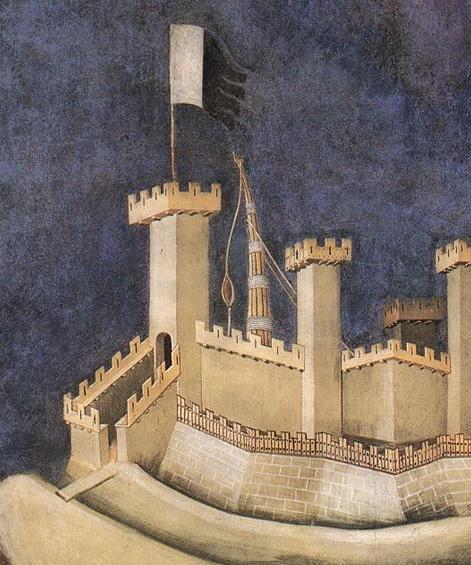
The use of increasingly better siege machines, and thus the increase in the weight and range of the missles, has affected the development of the fortification art. Initial palisades and walls began to be strengthened and raised, terraces were widened for own machines, and over time, a concentric double or triple wall systems were erected, thus protecting against breaches. In the 12th century, the traditional donjon, which was the strongest building in the castle, changed its form from quadrilateral to cylindrical, because the rounding of the wall turned out to be more resistant to missles fired from siege machines. In the 12th and 13th century, bergfried towers with spurs, facing the expected threat, became popular. Heavier missles resulted in the appearance of thicker walls, more frequent use of siege towers resulted in raising walls, and in particularly exposed places an exceptionally thick and high wall called a shield walls were built, which was to withstand fire and shield the building behind it. In turn, the use of flaming missiles caused a slow but inevitable resignation from wooden fortifications. Newly built castles were located in hard-to-reach terrain, above steep slopes, on high hills or areas protected by water, to make it difficult or impossible to approach siege machines. Often, the fortifications were so strong and inaccessible that the only chance to conquer the fortress was to dig under the walls or buildings. Progress in the construction of fortifications was also evident in the wider use of machicolation, hordings and more sophisticated arrowslits, as well as in smoothing the face of the walls to make it difficult to attach siege ladders.
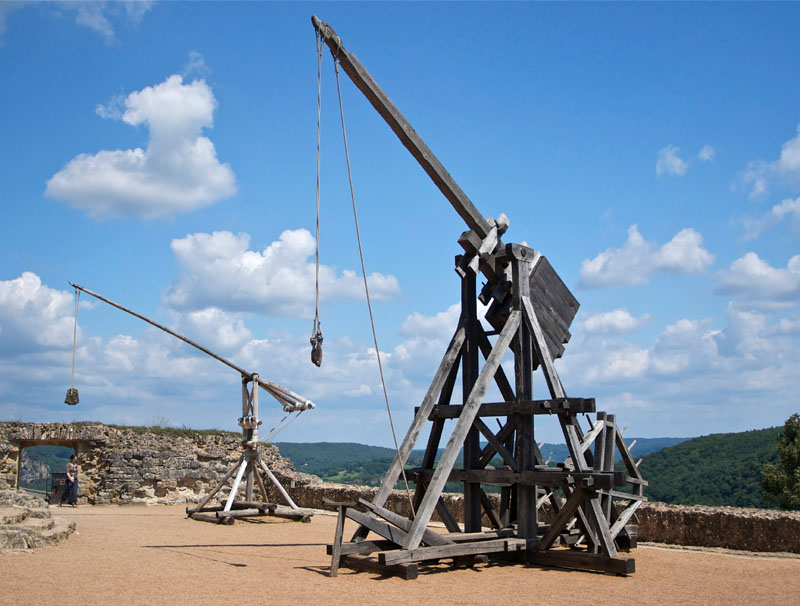
War machines in ancient times and in the Middle Ages often had different names depending on the time and place where they were created. Sometimes the name of a given device was changed many times, because the enemy who gained a machine, or created a similar one, gave it a different, own name. This led in the Middle Ages to a real chaos of terminology. Often the machines were called common names such as sows, vines, cats, weasels, etc. During the siege of Beaucaire by Simon de Montfort in 1216, a crusader commander ordered carpenters to make a “castle and a cat” out of wood, leather and iron. In 1304, during the siege of Stirling Castle, Edward I had thirteen machines, most of which had specific names.
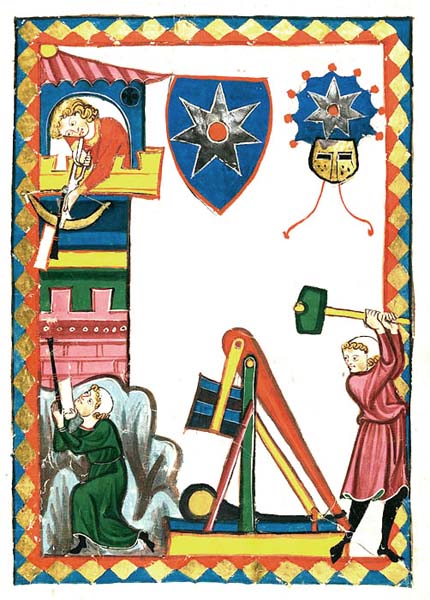
The decline of the importance of the throwing machines brought about the invention and spread of gunpowder (the first mentioned in the Chinese work from 1044). The new technology was, at first, more expensive to manufacture and operate, and less accurate and unreliable, but its constant development over time had to lead to the disappearance of old methods of warfare. However, it was a long process and carried out at different speeds in various parts of Europe, for example in its eastern regions mechanical siege machines were used until the eighteenth century. Even before 1380, no signs of decline were visible. French documents tell of hundreds of stones to machines during the reign of Charles V. In 1374 great devices were built by the Genoese to besiege Jacob de Lusignan in his castle Lérines, and in 1405 at the siege of Mortagne the French used the machine jaculatoria. A year later, a hundred carpenters labored in Saint Omer to build three large machines and four smaller couillarts. Around 1420, many tips suggest the vitality of the pre-powder artillery. Among other, to the machine located in the Saint Pol Monastery, the city of Orleans was then bought a bunch of leather skins and stones, and a year later Henry V intended to supply Paris with mechanical artillery. In 1422, during the campaign in Picardy, Philip the Good ordered eight couillarts. In France, inventories recorded the existence of such machines until 1460, so it seems that their disappearance in Western Europe occurred in the second half of the fifteenth century.
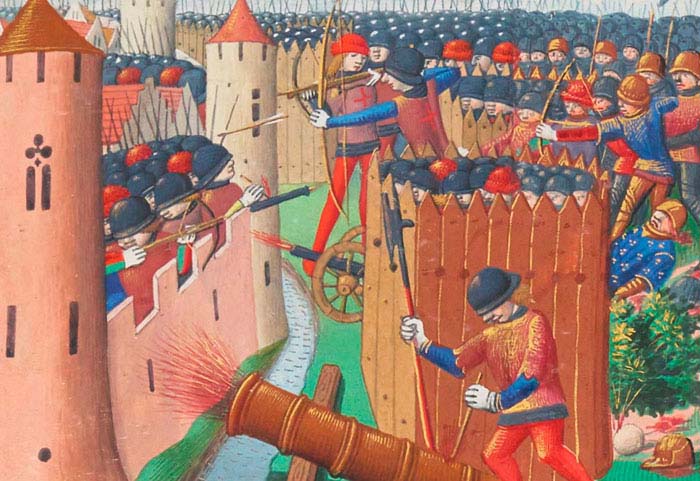
War machines are divided into many different categories, however, two basic classes are machines used for throwing missiles (mechanical artillery) and siege devices designed to directly demolishing of fortifications or facilitate their conquering, and to provide additional protection for fighters. In addition, the ancient Greeks introduced a distinction between machines due to the type of the missiles: oksybeleis – firing arrows and lithoboloi (petroboloi) – firing stones. Considering the source of energy needed to eject the missle, the throwing machines can also be divided into barobalistic (from the Greek baros – weight and ballo – throw), i.e. throwing with a double-sided lever, wchich shorter arm was additionally loaded, and neurobalistic (from the Greek neuron – string and ballo – throw), ejecting missiles as a result of relaxing elastic material in which energy is stored by twisting, squeezing or bending. The neurobalist machines as more complicated, and at the same time more delicate, peaked in popularity in antiquity and lost their popularity with the fall of the Roman Empire. In the Middle Ages, however, the development of barobalysts has survived. Due to the course of the missle, there is also a division into plunging and direct fire artillery.
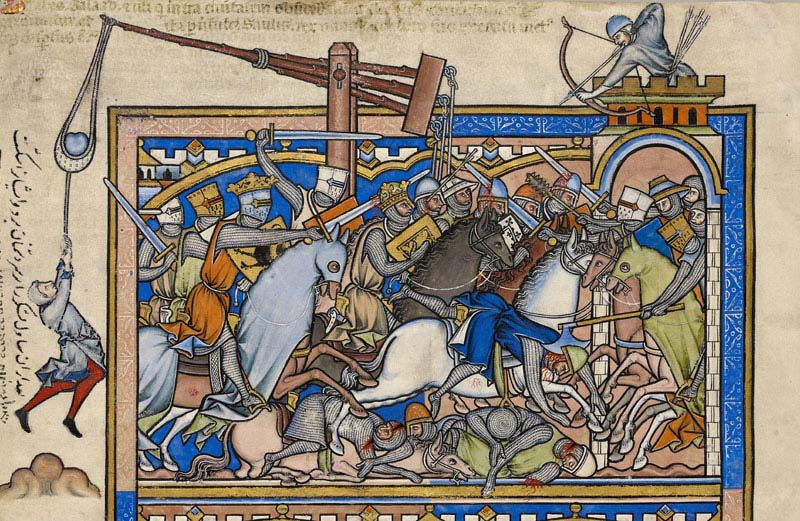
The post was made on the basis of excerpts from the book Roberta M.Jurga, Machiny wojenne. Zapomniana technika wojskowa, Poznań 2011, Budacz D., Antyczne formacje wojskowe, Oświęcim 2012 and Contamine P., Wojna w średniowieczu, Warszawa 2004.
At the very top a fragment of the Alba Bible from the first half of the fifteenth century.
